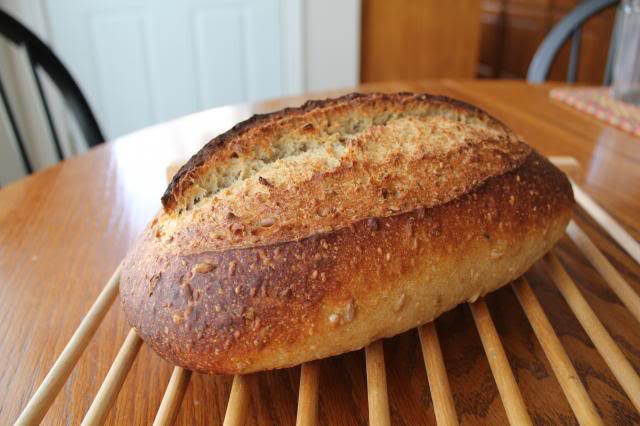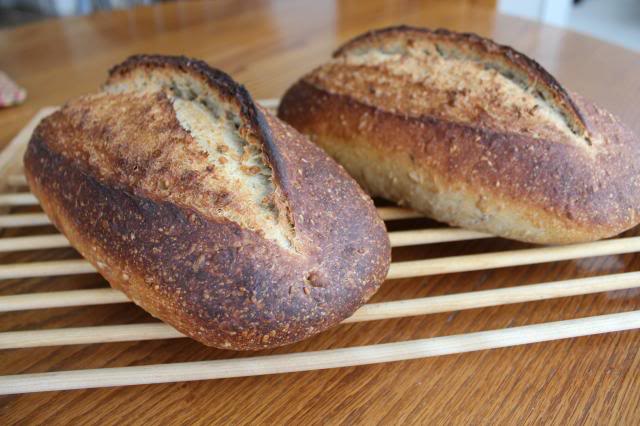
It was time for a break from the whole-grain breads that I have made, more often than not, in recent months. Even so, I wasn't looking for an all-white bread, either. In thumbing through the second edition of Hamelman's Bread, I came across his Sourdough Seed bread. It calls for a bit of rye flour, and a generous helping of flax, sesame, and sunflower seeds. Although there weren't any flax seeds on hand, I figured I could bluff my way through it with a bit of improvisation.
In casting about for something to substitute for the flax seed cold soaker, I came across some oatmeal that had been milled from oat groats while playing with the Kitchen Aide grain mill attachment. Okay, so oats are a cereal grain, which isn't what people usually mean when they refer to seeds. And these are ground up, not whole. Work with me, people, this is improv. So, flax seeds out, equal quantity of oat meal in. Cold water out, equal quantity of boiling water in. Now we have an oat meal scald, instead of a cold flax seed soaker.
Since my starter was at a healthy stage of development in the refrigerator, it went straight into the liquid levain with no preliminary feedings. By next morning, the levain was bubbly and ready to go. The oat meal scald was also ready, although not nearly so demonstrative, which was very much in keeping with its Scottish reserve.
Before mixing the dough, the sunflower and sesame seeds were toasted in the oven. Some stayed rather pale, others were a beautiful deep brown. After toasting, they were allowed to cool.
Per the instructions, the soaker (scald, in this case), the levain, the seeds, and the final dough ingredients were all combined and mixed. Mixing was done by hand, rather than by machine. The resulting dough at first appeared to be somewhat dry, since it required some work to get all of the flour absorbed. Once past that stage, it switched to being a rather sticky dough and stayed sticky throughout. This may have been an artifact of the oat meal scald. After mixing to a rough dough, it underwent another 8 minutes of slap and fold kneading. By the end of that workout, it was showing good gluten development.
The dough was shaped into a loose boule and placed in a plastic-covered bowl to ferment. About an hour and a quarter later, the dough was given a stretch and fold, then reshaped into a boule and returned to the bowl for roughly an hour and a half of additional fermentation. I was surprised when I uncovered the dough in preparation for shaping by the scent of peanut butter. It wasn't really that, on closer consideration, but that was how my brain first interpreted the the toasty/oily fragrance of the sunflower seeds and sesame seeds in the dough.
At the end of the bulk fermentation, the dough was divided in two. Each piece was pre-shaped, allowed to rest for a few minutes, then given a final shaping as a batard. Final proofing was in parchment couches with side support. It took nearly three hours of final proofing before the bread was ready for baking; kitchen temperatures were in the 70-72F range yesterday.
Baking was pretty much as instructed, with steam. I chose to go a few minutes longer with the bake to get a darker crust color. The bread was removed from the oven when the internal temperature was 207F.
While I would have liked additional oven spring, that may not be a reasonable expectation, given the load of the seeds and the scald. Both loaves have a lovely ear. The coloring of the grigne shows that the bread continued to expand throughout the bake. I had noticed a lot of condensation of the steam on the surface of the loaves a couple of minutes into the bake, which helped keep the crust soft and allow good expansion.
Here's another picture of the baked loaves:

The crumb, when I cut some slices for toast this morning, has a range of bubble sizes:

None are especially large, but, when you look at the seed distribution, there really isn't much they could have grown without banging into a seed of some kind. The crust was initially very hard. After 24 hours in plastic, it has softened somewhat. The crumb is very moist and cool, some of which I attribute to the oat meal scald. The flavor is definitely tilted in the direction of the toasted seeds,with plenty of nutty and toasty notes. I can't distinguish the oat meal or the rye flour as individual flavors, although I am certain that they are part of the background grainy flavors. The crust contributes hints of caramel, as well. Overall, it's a very good bread that I enjoyed toasted and expect to enjoy as the foundation for sandwiches. My thanks to Chef Hamelman for creating a bread that is still good in spite of my unanticipated variation.
Paul